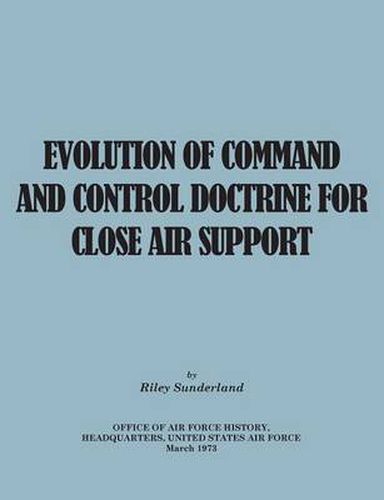Readings Newsletter
Become a Readings Member to make your shopping experience even easier.
Sign in or sign up for free!
You’re not far away from qualifying for FREE standard shipping within Australia
You’ve qualified for FREE standard shipping within Australia
The cart is loading…






This title is printed to order. This book may have been self-published. If so, we cannot guarantee the quality of the content. In the main most books will have gone through the editing process however some may not. We therefore suggest that you be aware of this before ordering this book. If in doubt check either the author or publisher’s details as we are unable to accept any returns unless they are faulty. Please contact us if you have any questions.
This study was prepared in response to an Air Staffrequest for a history of command and control procedures used in close air support (CAS). The writer, Mr. Riley Sunderland, is co-author of the official Army history of the China-Burma-IndiaTheater, World War II, and wrote 5 RAND Corp. studies of the Communist insurgency in Malaya. He begins with brief comment on the invention of close air support during World War I, then moves on to the evolution of the modern Tactical Air Control System (TACS) from the late 1930’s to thepresent. Only major developments are treated to keep the subject manageable.The author, distinguishing between doctrine and procedure, has focused on the former. For official definitions of doctrine and close air support, the reader is referred to Air Force Manual (AFM) 11-1, USAF Glossary of Standardized Terms.Close air support is the third of 3 principal missions of tactical air forces, of which air superiority is first and interdiction second. The classic statement is in War Department Field Manual (FM) 100-20, Command and Employment of Air Power, 21 July 1943, paragraph 16. Close air support may also be provided by strategic air, e.g., St. Lo, France, 1944; Khe Sanh, South Vietnam, 1968. The responsible air commander must weigh the allocation of resources betweenthe 3 basic tactical air missions, lest an injudicious commitment of his forces to any one mission degrades his ability to perform the others. As will be seen in Mr. Sunderland’s narrative, this has been a major issue in the handling of tactical air.
$9.00 standard shipping within Australia
FREE standard shipping within Australia for orders over $100.00
Express & International shipping calculated at checkout
This title is printed to order. This book may have been self-published. If so, we cannot guarantee the quality of the content. In the main most books will have gone through the editing process however some may not. We therefore suggest that you be aware of this before ordering this book. If in doubt check either the author or publisher’s details as we are unable to accept any returns unless they are faulty. Please contact us if you have any questions.
This study was prepared in response to an Air Staffrequest for a history of command and control procedures used in close air support (CAS). The writer, Mr. Riley Sunderland, is co-author of the official Army history of the China-Burma-IndiaTheater, World War II, and wrote 5 RAND Corp. studies of the Communist insurgency in Malaya. He begins with brief comment on the invention of close air support during World War I, then moves on to the evolution of the modern Tactical Air Control System (TACS) from the late 1930’s to thepresent. Only major developments are treated to keep the subject manageable.The author, distinguishing between doctrine and procedure, has focused on the former. For official definitions of doctrine and close air support, the reader is referred to Air Force Manual (AFM) 11-1, USAF Glossary of Standardized Terms.Close air support is the third of 3 principal missions of tactical air forces, of which air superiority is first and interdiction second. The classic statement is in War Department Field Manual (FM) 100-20, Command and Employment of Air Power, 21 July 1943, paragraph 16. Close air support may also be provided by strategic air, e.g., St. Lo, France, 1944; Khe Sanh, South Vietnam, 1968. The responsible air commander must weigh the allocation of resources betweenthe 3 basic tactical air missions, lest an injudicious commitment of his forces to any one mission degrades his ability to perform the others. As will be seen in Mr. Sunderland’s narrative, this has been a major issue in the handling of tactical air.